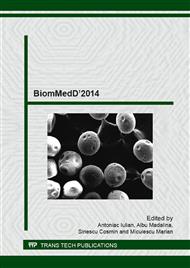[1]
APA. American Psychiatric Association, Diagnostic and Statistical Manual of Mental Disorders (DSM-IV), 4th ed. American Psychiatric Association, Washington, DC, USA, (2000).
DOI: 10.1007/springerreference_179660
Google Scholar
[2]
S.D. Mayes and S.L. Calhoun, Frequency of reading, math, and writing disabilities in children with clinical disorders, Learning and Individual Differences. 16 (2006) 145-157.
DOI: 10.1016/j.lindif.2005.07.004
Google Scholar
[3]
K.R. Ota and G.J. DuPaul, Task Engagement and Mathematics Performance in Children with Attention-Deficit Hyperactivity Disorder: Effects of Supplemental Computer Instruction, School Psychology Quarterly. 17(3) (2002) 242-257.
DOI: 10.1521/scpq.17.3.242.20881
Google Scholar
[4]
R. Shaw, A. Grayson and V. Lewis, Inhibition, ADHD, and Computer Games: The Inhibitory Performance of Children with ADHD on Computerized Tasks and Games, Journal of Attention Disorders. 8(4) (2005) 160-168.
DOI: 10.1177/1087054705278771
Google Scholar
[5]
T.S. Tan and W.S. Cheung, Effects of Collaborative Group Work on Peer Acceptance of a Junior Pupil with Attention Deficit Hyperactivity Disorder. Computers & Education. 50 (2008) 725-741.
DOI: 10.1016/j.compedu.2006.08.005
Google Scholar
[6]
M. Kebritchi, A. Hirumi and B.A.I. Haiyan, The Effects of Modern Mathematics Computer Games on Mathematics Achievement and Class Motivation. Computers & Education. 55 (2010) 427-443.
DOI: 10.1016/j.compedu.2010.02.007
Google Scholar
[7]
S. Kim and M. Chang, Computer Games for the Math Achievement of Diverse Students. Educational Technology & Society. 13(3) (2010) 224-232.
Google Scholar
[8]
A.P. Silva and A.F. Frère, Virtual environment to quantify the influence of colour stimuli on the performance of tasks requiring attention, Biomedical Engineering Online. 10(74) (2011).
DOI: 10.1186/1475-925x-10-74
Google Scholar
[9]
T. Banaschewsky, S. Rupert, R. Tannock, B. Albrecht, A. Becker, H. Uebel, J.A. Sergeant and A. Rothenberger, Colour perception in ADHD, Journal of Child Psychology and Psychiatry. 47(6) (2006) 568-572.
DOI: 10.1111/j.1469-7610.2005.01540.x
Google Scholar
[10]
V. Roessner, T. Banaschewski, A. Fillmer-Otte, A. Becker, B. Albrecht, H. Uebel, J. Sergeant, R. Tannock and A. Rothenberger, Color perception deficits in co-existing attention deficit/ hyperactivity disorder and chronic tic disorders, Journal of Neural Transmission. 115(2) (2008).
DOI: 10.1007/s00702-007-0817-2
Google Scholar
[11]
R. Tannock, T. Banaschewski and D. Gold, Color naming deficits and attention-deficit / hyperactivity disorder: A retinal dopaminergic hypothesis. Behavioral and Brain Functions. 2(4) (2006).
DOI: 10.1186/1744-9081-2-4
Google Scholar
[12]
Blender 3D. Information on http: /www. blender. org.
Google Scholar
[13]
R.S. Pressman, Software engineering: a practitioner's approach, 7th ed., McGraw-Hill, New York, (2010).
Google Scholar
[14]
A. Koscianski and M.S. Soares, Qualidade de Software, second ed. Novatec Editora, São Paulo, (2007).
Google Scholar
[15]
Ministério da Educação (MEC). Parâmetros Curriculares Nacionais (PCN): Matemática. Secretaria de Educação Fundamental. Brasília, 1997. Information on portal. mec. gov. br/seb/arquivos/pdf/livro01. pdf.
Google Scholar
[16]
G.J. Myers, C. Sandler and T. Badgett, The Art of Software Testing, third ed., John Wiley & Sons, Inc., Hoboken, New Jersey, (2011).
Google Scholar
[17]
D. Daley and J. Birchwood, ADHD and academic performance: why does ADHD impact on academic performance and what can be done to support ADHD children in the classroom? Child: Care, Health and Development. 36(4) (2010) 455-464.
DOI: 10.1111/j.1365-2214.2009.01046.x
Google Scholar


